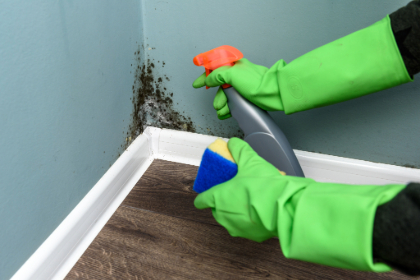BLOG
Think you've got mold under control? Watch out for these DIY mold removal mistakes! Archer Cleaning & Restoration Services in St. Croix Falls, WI, shares how to stay safe.

Mold Is Sneaky—Don’t Let It Fool You!
Picture this: You spot a patch of mold in your basement and grab the nearest bottle of bleach, ready to wage war. But here’s the problem—mold isn’t just a surface-level nuisance. It’s a stubborn, health-threatening invader that, if not treated correctly, can grow rapidly.
Mold removal at home can be effective, but one wrong move can spread spores, worsen contamination, or even make you sick. Before you start scrubbing, let’s discuss the biggest DIY mold removal mistakes people make—and how to outsmart mold for good.
From basement floods to chimney fires and stubborn mold, Archer Cleaning & Restoration Services in St. Croix Falls, WI, is here for you. Call 888-436-3499 and get the expert help your home deserves. Fast, professional, and caring — we're ready when you need us most.
Mistake #1: "I Don’t Need a Mask—It’s Just a Little Mold!"
Mold spores are microscopic but hazardous. Breathing them in can trigger allergies, asthma attacks, or worse. Yet, so many DIYers skip the goggles, gloves, and respirator, thinking a bandana or dust mask is enough. This is a big mistake!
Do this instead: Treat mold like hazardous material. Wear an N95 mask (or better), nitrile gloves, goggles, and disposable coveralls. No exceptions—your lungs will thank you.
Mistake #2: "If I Can’t See It, It’s Not There!"
You scrub the black spots off your shower tiles and call it a day. But mold is a master of hide-and-seek. It lurks behind walls, under flooring, inside air ducts—anywhere moisture hides.
Do this instead: Follow your nose. A musty smell is mold’s calling card. Use a moisture meter to find damp spots and inspect hidden areas like attics and crawl spaces. If you don’t find the source, the mold will come back.
Mistake #3: "Bleach Kills Everything, Right?"
Bleach is great for disinfecting countertops, but it’s a terrible mold killer on porous surfaces like drywall or wood. Why? It only cleans the surface while the roots stay buried. Plus, bleach is mostly water—and mold loves water.
Do this instead: Skip the bleach for vinegar, hydrogen peroxide, or EPA-approved mold cleaners. They penetrate deeper and don’t feed the problem.
Mistake #4: "A Fresh Coat of Paint Will Cover It Up!"
It’s tempting to slap some paint over mold and pretend it never happened. But mold doesn’t care about your home makeover—it’ll keep growing underneath, eating away at your walls.
Do this instead: Remove all mold first, then use a mold-resistant primer (like Kilz) before painting. Otherwise, you’re just giving mold a cozy place to thrive.
A disaster at your home in St Croix Falls deserves fast, expert assistance. Trust Archer Cleaning & Restoration Services to step in with 24/7 support and a caring touch. Call 888-436-3499 today and let them restore your home—and your peace of mind.
Mistake #5: "I Can’t Throw This Away—It’s Sentimental!"
That moldy couch from Grandma? The water-damaged photo albums? We get it—some things feel irreplaceable. But moldy, porous materials (carpets, upholstery, drywall) can’t be fully cleaned. Keeping them risks spreading spores.
Do this instead: Bag heavily contaminated items in sealed plastic and dispose of them properly. Your health is worth more than a musty keepsake.
Mistake #6: "Scrubbing Harder Will Fix It!"
Aggressive scrubbing seems logical, but it’s a trap. Disturbing mold sends millions of spores airborne, spreading them to new areas of your home.
Do this instead:
- Seal off the area with plastic sheeting.
- Lightly mist mold before cleaning (it keeps spores from flying).
- Use a HEPA vacuum (regular vacuums just blow spores around).
Mistake #7: "The Mold Is Gone—I’m Done!"
You cleaned every speck of mold… but did you fix the leaky pipe, condensation, or poor ventilation that caused it? If not, mold will be back in days—guaranteed.
Do this instead:
- Fix leaks ASAP.
- Run a dehumidifier (keep humidity under 50%).
- Improve airflow (fans, open windows, exhaust vents).
Mistake #8: "I Can Handle This Massive Infestation Myself!"
Some mold jobs are way beyond DIY. If you’re dealing with black mold, HVAC contamination, or more than 10 square feet, you need a pro. Trying to handle it yourself can leave hidden mold behind—leading to bigger (and costlier) problems later.
Do this instead: Call a mold remediation specialist if:
- The infestation is large or widespread.
- You suspect toxic mold (like Stachybotrys).
- Mold keeps returning no matter what you do.
DIY mold removal mistakes can put your health at risk. Trust Archer Cleaning & Restoration Services in St Croix Falls, WI, to handle it right. Call 888-436-3499 today for expert mold removal and a safer home!
Archer Restoration
is a Proud Sponsor of the
Club 905 Polk County Scholarship Fund
Supporting Community Law Enforcement
and Emergency Service Providers
Location








